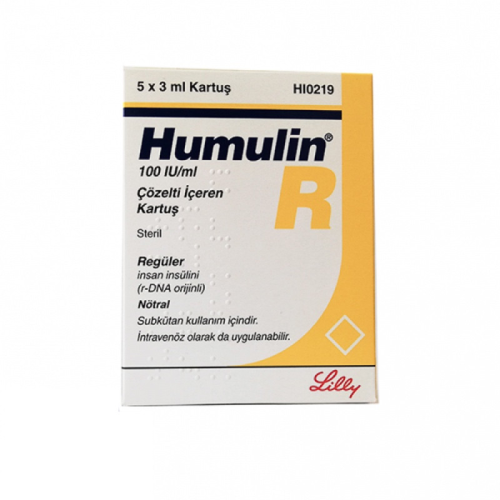Humulin R 100IU (Cart)
- Brand: Lilly
- Product Code: Humulin R 100IU (Cart)
- Availability: In Stock
-
$62.00
CLASSIFICATION
Hormone and Synthetic Substitute / Antidiabetic Agent
ACNE
No
WATER RETENTION
No
HBR
No
HEPATOTOXICITY
No
AROMATIZATION
No
MANUFACTURER
Lilly
WAREHOUSE
International Warehouse 2
SUBSTANCE
Insulin
,
Insulin is a potent anabolic hormone that is produced by all humans and is crucial for maintaining proper bodily functions. While it is naturally generated in the body, individuals with diabetes often require external (exogenous) insulin. Some athletes also use it to aid in the development of lean muscle mass. However, using insulin off-label carries significant risks and should be approached with extreme caution.
Exogenous insulin first emerged in the 1920s, sourced originally from the pancreases of dogs, and later from cattle and pigs. Although concerns about purity existed, exogenous insulin was highly valued for its life-saving potential. Untreated diabetes can be lethal, and while animal-derived insulin was not perfect, its benefits outweighed the risks. By the 1970s, issues of purity had largely been addressed, leading to the introduction of synthetic insulin by Ciba in 1975. The synthetic form was further refined with the release of Humulin-R in 1982, which is identical to human insulin and has been FDA-approved.
Insulin Functions & Characteristics:Insulin is secreted by the pancreas and is classified as a peptide hormone responsible for managing the use and regulation of glucose, amino acids, and fatty acids. It helps prevent the metabolic breakdown of glycogen, fat, and protein.
For individuals with diabetes, insulin can be essential for two types of the disease. In Type 1 diabetes, patients do not produce sufficient insulin, while those with Type 2 diabetes may produce it but the body does not utilize it effectively, often a result of obesity.
As a peptide hormone from the pancreas, insulin positively influences the liver to convert glycogen into glucose and inhibits the conversion of non-carbohydrates into glucose. It also facilitates the transport of glucose into cells, promoting muscle growth. High insulin levels are associated with increased protein synthesis and improved bone density, as well as boosting Insulin-Like Growth Factor-1 (IGF-1), a hormone similar to insulin with anabolic properties.
Beyond its metabolic functions, insulin also appears to increase levels of Luteinizing Hormone (LH) and Follicle Stimulating Hormone (FSH), which can subsequently elevate testosterone production in the body. Although the influence on LH and FSH is not substantial, it is still noteworthy.
Effects of Insulin:The primary effect of insulin, regardless of diabetes type, is the management of blood sugar levels. Due to its strong anabolic and anti-catabolic effects, insulin can be advantageous for certain athletes. However, non-diabetic individuals who use it are at risk of significant fat gain and other dangerous consequences if they do not use it correctly.
Despite the dangers, some athletes deem insulin beneficial for its anabolic and anti-catabolic properties. Nevertheless, maintaining control over body fat is crucial; high insulin levels can greatly reduce the body's capacity to burn existing fat. To mitigate negative metabolic effects and optimize insulin's anabolic benefits, it should ideally be administered right after intense weight training, accompanied by appropriate nutrition.
When used correctly, insulin can facilitate the development of lean muscle mass relatively quickly. While many find it challenging to manage fat gain, it is achievable with careful planning. Combining insulin with anabolic steroids and Human Growth Hormone (HGH) is common among athletes to enhance growth and improve fat control.
Side Effects of Insulin:The potential side effects of insulin primarily involve hypoglycemia, which can be of particular concern in performance contexts. Although not typically a problem for diabetic patients using proper dosages, athletes face heightened risks. Hypoglycemia occurs when blood sugar levels drop too low, leading to a range of symptoms including dizziness, hunger, drowsiness, blurred vision, and more. These symptoms can escalate and may even result in death if not managed properly.
If hypoglycemic symptoms arise, immediate intake of fast-acting carbohydrates—like candy or sugary drinks—is crucial. Importantly, individuals should not sleep after administering insulin due to the risk of experiencing severe hypoglycemia overnight. In the event of severe symptoms, urgent medical assistance is required, underscoring the importance of having someone nearby during insulin use.
Serious hypoglycemia can lead to diabetic coma, and fatalities linked to improper use of insulin in performance contexts highlight the gravity of the situation.
In addition to hypoglycemia, insulin use may cause allergic reactions at the injection site, including swelling and irritation, though these instances are rare. More serious reactions, such as rash or respiratory difficulties, while uncommon, necessitate medical attention.
Repeated injections in the same area can lead to increased fat storage in that region, so it is advisable to rotate injection sites.
Insulin Administration:For diabetes management, insulin dosages vary widely based on individual needs, with no universal standard. When it comes to performance enhancement, various forms of insulin are available, and the selection significantly impacts the dosage plan. Fast-acting insulins like Humulin-R, Humalog, and Novolog are typically preferred by athletes.
Humalog acts relatively quickly, with effects visible within 15 minutes after injection and peak levels attained in 30-90 minutes, lasting about 3-5 hours. Novolog and Humulin-R have similar characteristics but tend to be slower-acting. Humulin-R is available over the counter, making it more accessible for many athletes, while Humalog requires a prescription.
For performance purposes, a common starting dosage is 1 unit of insulin per 10 pounds of body weight, although novices should begin with lower amounts—about 1 unit post-training—and gradually increase as tolerated. If signs of hypoglycemia occur, it indicates the dosage may have been too high.
The optimal timing for insulin administration is immediately after weight training, supplemented by a minimum of 100 grams of carbohydrates alongside protein—approximately 40-50 grams. It’s important to keep fast-acting carbohydrates readily available to counter hypoglycemic reactions, and a subsequent meal should be planned soon after.
Insulin in Review:Insulin is essential for health and bodily function. As a performance-enhancing tool, it can significantly aid muscle building, but the associated risks are considerable. Many individuals may find they do not need insulin for their fitness goals and may ultimately be better off avoiding it, despite its allure in competitive bodybuilding contexts. Some athletes may also exploit insulin's undetectability in drug tests, using it along with HGH and small doses of testosterone or thyroid medications to navigate testing challenges, typically at lower total doses.

